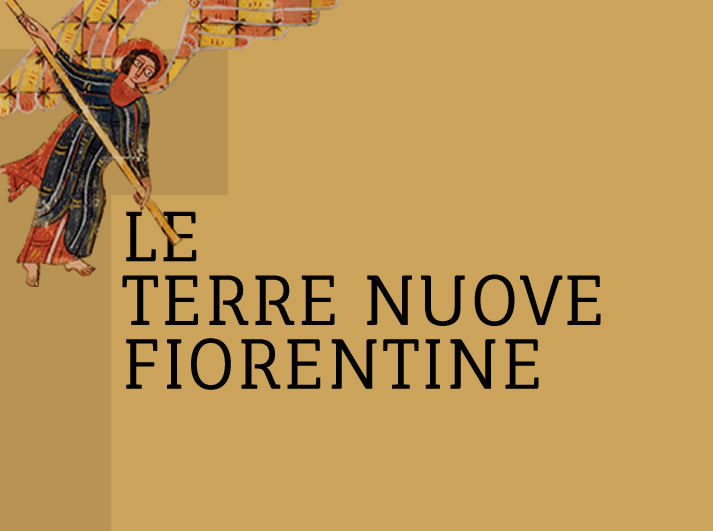

Although the phenomenon of “incastellation” had already existed in Tuscany since the beginning of the 13th century, Florence was later than other Tuscan towns in this respect and began to establish new towns only from the end of the century.
The Florentine New Lands followed the two main road axes of the time: Firenzuola and Castel San Barnaba (Scarperia) on the Florence-Bologna axis; Castelfranco, Castel San Giovanni (San Giovanni Valdarno) and Terra Santa Maria (Terranuova Bracciolini) on the Florence-Rome axis. The construction of Giglio Fiorentino was also envisaged, but was never carried out.
How the People of Florence made the Land of Castello San Giovanni and Castello Franco in Valdarno. In the said year, being the municipality and the people of Florence in a good and happy state, even though the nobility had begun to contradict the people, as we have said, the people, in order to fortify themselves better in the countryside and to diminish the power of the nobles and of the powerful of the countryside, especially that of the Pazzi di Val d’Arno and the Ubertini, who were Ghibellines, ordered that two large castles and lands be made in Valdarno; one was between Feghine and Montevarchi, and was called Castello Santo Giovanni; the other was in the Uberti district on the opposite side of the Arno, and was called Castello Franco, and all the inhabitants of the said castles were freed for ten years from all communal duties and expenses, so that many of the faithful of the Pazzi and Ubertini families, and those of Ricasoli and of the Conti and other nobles, in order be freed men, became dwellers of the said castles; on account of which these grew and multiplied in a short time, and made themselves fruitful and large lands.
In fact, between 1299 and 1350 Florence planned six new settlements and to this day, when we speak of the Florentine Terre Nuove, we tend to refer exactly to these six settlements: San Giovanni Valdarno, Terra Santa Maria (Terranuova Bracciolini), Castelfranco di Sopra, Castel San Barnaba (today’s Scarperia), Firenzuola and Giglio Fiorentino to which, however, should be added Vicchio di Mugello, Tartigliese in the Upper Valdarno and Castel San Pietro in Val di Sieve, which had a different fate in some respects from the other Terre.
These were centres that the Republic had built ex novo between the end of the thirteenth century and the beginning of the fourteenth century, mainly for anti-seigniory purposes: small urban centres designed from scratch on paper, inspired by principles of regularity and optimisation, all sharing a number of common features.
As David Friedman notes, these foundations stood out for the originality of their urban planning and the engineering precision with which they were realised.
However, we can attempt to make an initial general distinction into two groups. The foundations that appeared in the Upper Valdarno – namely Castelfranco, San Giovanni, Terra Santa Maria – responded to the need to govern a territory that Florence had recently acquired to the south-east, in the direction of Arezzo and Rome.
The other three foundations, only two of which were fully realised, were deliberated shortly afterwards (Castel San Barnaba and Firenzuola in the spring of 1306, and finally Giglio Fiorentino, unrealised, was planned in 1350) and concerned a different geographical area, namely that of Mugello, north of Florence. The purposes of Scarperia and Firenzuola were expressly defensive: their foundation was a matter of putting in place a soft but unavoidable system to repress and contain the pride of certain branches of the Ubaldini family, lords of the Apennine area.
(The text is taken from the museum guide, edited by Claudia Tripodi and Valentina Zucchi, Sagep, 2024)
The New Lands Museum
We firmly believe that the internet should be available and accessible to anyone, and are committed to providing a website that is accessible to the widest possible audience, regardless of circumstance and ability.
To fulfill this, we aim to adhere as strictly as possible to the World Wide Web Consortium’s (W3C) Web Content Accessibility Guidelines 2.1 (WCAG 2.1) at the AA level. These guidelines explain how to make web content accessible to people with a wide array of disabilities. Complying with those guidelines helps us ensure that the website is accessible to all people: blind people, people with motor impairments, visual impairment, cognitive disabilities, and more.
This website utilizes various technologies that are meant to make it as accessible as possible at all times. We utilize an accessibility interface that allows persons with specific disabilities to adjust the website’s UI (user interface) and design it to their personal needs.
Additionally, the website utilizes an AI-based application that runs in the background and optimizes its accessibility level constantly. This application remediates the website’s HTML, adapts Its functionality and behavior for screen-readers used by the blind users, and for keyboard functions used by individuals with motor impairments.
If you’ve found a malfunction or have ideas for improvement, we’ll be happy to hear from you. You can reach out to the website’s operators by using the following email
Our website implements the ARIA attributes (Accessible Rich Internet Applications) technique, alongside various different behavioral changes, to ensure blind users visiting with screen-readers are able to read, comprehend, and enjoy the website’s functions. As soon as a user with a screen-reader enters your site, they immediately receive a prompt to enter the Screen-Reader Profile so they can browse and operate your site effectively. Here’s how our website covers some of the most important screen-reader requirements, alongside console screenshots of code examples:
Screen-reader optimization: we run a background process that learns the website’s components from top to bottom, to ensure ongoing compliance even when updating the website. In this process, we provide screen-readers with meaningful data using the ARIA set of attributes. For example, we provide accurate form labels; descriptions for actionable icons (social media icons, search icons, cart icons, etc.); validation guidance for form inputs; element roles such as buttons, menus, modal dialogues (popups), and others. Additionally, the background process scans all the website’s images and provides an accurate and meaningful image-object-recognition-based description as an ALT (alternate text) tag for images that are not described. It will also extract texts that are embedded within the image, using an OCR (optical character recognition) technology. To turn on screen-reader adjustments at any time, users need only to press the Alt+1 keyboard combination. Screen-reader users also get automatic announcements to turn the Screen-reader mode on as soon as they enter the website.
These adjustments are compatible with all popular screen readers, including JAWS and NVDA.
Keyboard navigation optimization: The background process also adjusts the website’s HTML, and adds various behaviors using JavaScript code to make the website operable by the keyboard. This includes the ability to navigate the website using the Tab and Shift+Tab keys, operate dropdowns with the arrow keys, close them with Esc, trigger buttons and links using the Enter key, navigate between radio and checkbox elements using the arrow keys, and fill them in with the Spacebar or Enter key.Additionally, keyboard users will find quick-navigation and content-skip menus, available at any time by clicking Alt+1, or as the first elements of the site while navigating with the keyboard. The background process also handles triggered popups by moving the keyboard focus towards them as soon as they appear, and not allow the focus drift outside it.
Users can also use shortcuts such as “M” (menus), “H” (headings), “F” (forms), “B” (buttons), and “G” (graphics) to jump to specific elements.
We aim to support the widest array of browsers and assistive technologies as possible, so our users can choose the best fitting tools for them, with as few limitations as possible. Therefore, we have worked very hard to be able to support all major systems that comprise over 95% of the user market share including Google Chrome, Mozilla Firefox, Apple Safari, Opera and Microsoft Edge, JAWS and NVDA (screen readers).
Despite our very best efforts to allow anybody to adjust the website to their needs. There may still be pages or sections that are not fully accessible, are in the process of becoming accessible, or are lacking an adequate technological solution to make them accessible. Still, we are continually improving our accessibility, adding, updating and improving its options and features, and developing and adopting new technologies. All this is meant to reach the optimal level of accessibility, following technological advancements. For any assistance, please reach out to

